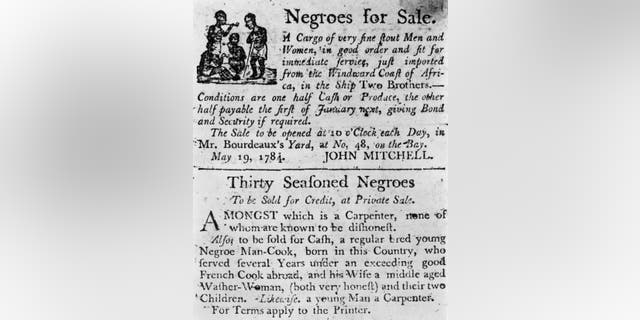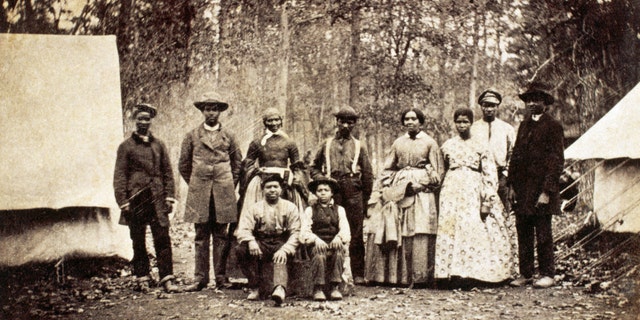by Hannah Grossman
One critic of the project described it as 'history told through the lens of critical race theory'
Since the 1619 Project was founded by New York Times Magazine reporter Nikole Hannah-Jones in August 2019, it has been marred with credible accusations of historical distortions and inaccuracies. Despite this bipartisan backlash, it continues to be integrated in school curriculums across the country because it is considered a factual historical narrative that has the prestigious backing of a legacy paper.
For example, Randi Weingarten, the union president of the American Federation of Teachers, denied the project peddles falsehoods.
"All of a sudden you're hearing people ... who are trying to ban the 1619 Project, because it is trying to … actually teach a factual version of oppression in America," she said.
The project is shielded with an abundance of praise from liberal media, with ABC’s Robin Roberts calling it a symbol of courage and "truth," and MSNBC's Joy Reid saying it is a "phenomenal piece of journalism."
Many historians have peeked behind the curtain of New York Times prestige and found factual inaccuracies, which some go as far to condemn as "anti-historical."

AP Photo/John Minchillo, File 1619 Book cover: Amazon (AP Photo/John Minchillo)
"The 1619 Project is the perfect tool for making angry, anti-American student activists," Mary Grabar told Fox News. The author of "Debunking the 1619 Project," believes Hannah-Jones' creation is, essentially, "history told through the lens of critical race theory, … substitute[ing] objectivity with narrative storytelling."
"[The Project] engages students, and it makes them activists, which is what a lot of teachers want to do. There are way too many woke teachers. They've been trained in colleges of education to produce not knowledgeable citizens, but left-wing social activists."
After the project was published in the magazine, five historians penned a letter to The New York Times demanding corrections for the errors they found. The most significant error was that The American Revolution was fought in order to preserve slavery when most historians say it was a disrupter of slavery.
During the fact-checking process, The Times reached out to Leslie Harris, a professor at Northwestern who has specialized knowledge of pre-Civil War American history, to help verify some claims. She told Fox News Digital that despite her objections to the claim that the American Revolution was fought to preserve the institution of slavery, The Times went forward with it anyway.
Disagreements with some parts of it notwithstanding, professor Harris believes The Times' project is "a much-needed corrective to the blindly celebratory histories that once dominated our understanding of the past." Teachers can present the 1619 Project within the context of the rich public discourse surrounding it and the feedback historians have inputted into the conversation, she said.
"It's a legacy," she said. "We are happy to look at the Founding Fathers' legacies of freedom. We don't very much question that we still believe in freedom … [Likewise,] it is a different racism [that evolved over hundreds of years] … but the root of it is still in that early time period."

Two advertisements in a colonial broadside newspaper: one for a cargo of slaves just imported from Africa on the ship Two Brothers, and one for 'Thirty Seasoned Negroes', including a carpenter, a cook and the cook's family. (MPI/Getty Images)
However, other historians disagree the project is salvageable.
"Of course, slavery was part of the history of the United States," political science professor at Kentucky State University Wilfred Reilly told Fox News. "The problem with the 1619 Project is that it makes extraordinary sweeping claims."
"The claim isn't that … [for the] first 80 years of American history, we had slavery," he said. Instead, The Times claims American history should be reframed to have the start date of 1619 when the first slaves are believed to have arrived, not when the Declaration of Independence was signed in 1776.
"It's important to get the dates here correct. I mean, in 1619 there wasn't any United States of America," Reilly said.

"Declaration of Independence" - detail of the painting by John Trumbell. Undated color slide. ("Declaration of Independence" - detail of the painting by John Trumbell)
Furthermore, James Oakes, a distinguished professor at the CUNY Graduate Center, adds that the 1619 Project made sweeping claims that clash with the history of the abolitionist and Civil Rights movement.
"When you say racism is built into the DNA of the United States, or that it's America's original sin – [it means] those things are unchanging," he said. "And that, to me, is not just ahistorical, it's almost anti-historical."
"There have always been large numbers of Whites divided among themselves in alliance with Blacks and in the struggle against slavery and racial discrimination," Oakes continued. "The 1619 Project erases that and instead posits a racial consensus among Whites that is unchanging."

Group of freed slaves who worked as laborers and servants with the 13th Massachusetts Infantry Regiment during the American Civil War, 1862. (Photo by © CORBIS/Corbis via Getty Images)
The 1619 Project's theories of American history were later developed into a curriculum with the help of the Pulitzer Center. According to the nonprofit, hundreds of schools have received copies of The Times' magazine issue and over 4,000 educators are using resources from 1619.
Even Times columnist Bret Stephens challenged the paper's decision to bring their agenda into schools, calling it an "overreach" to try and have the final word on history.
"[J]ournalists ... come under relentless political assault from critics who accuse us of being fake, biased, partisan and an arm of the radical left. Many of these attacks are baseless. Some of them are not. Through its overreach, the 1619 Project has given critics of The Times a gift," Stephens wrote. "It’s one thing for a newspaper to publish the 1619 Project by way of challenging its subscribers," he said. "It’s quite another to become a pedagogical product for schoolchildren who, along with their parents, in most cases probably don’t subscribe. This was stepping into the political fray in a way that was guaranteed to invite not just right-wing blowback, but possible federal involvement."
THE NEW YORK TIMES' JOURNEY FROM PAPER OF RECORD TO HOME OF THE 1619 PROJECT
A researcher, who focuses on The Times, Ashley Rindsberg, told Fox News Digital that the legacy paper has a long history of using unethical practices to shape the narrative.
"What really bothered me [about the 1619 Project] was that [The New York Times] was so willing to advance the narrative … not even at the expense of the truth, but to change the very conception of what the truth is," Rindsberg said, author of "The Gray Lady Winked."
As a life-long Times reader, Rindsberg began investigating the paper when he moved to Israel and observed how their reporting on the conflict didn't match the facts he was witnessing on the ground.
"When I came to Israel in my mid-twenties … from the U.S. [and] … as a New York Times reader [I realized what] I was reading … just did not match reality," he said.

Israeli Iron Dome air defense system launches to intercept rockets fired from Gaza Strip, near Sderot, Israel, Thursday, May 13, 2021. (AP Photo/Ariel Schalit) (AP Photo/Ariel Schalit)
According to Rindsberg, the 1619 Project is part of a larger picture of reckless disregard for the truth at the legacy paper that has become part of their newsroom.
"I think the key message to understand is that [The 1619 Project] is not history … it really is about present-day ideology and power," he continued.
On The Times' strategy, Rindsberg said the so-called paper of record is empowered by falsehood.
"When you say I'm just going to let go of the truth, you're no longer constrained by it. It's actually quite brilliant, a bit perverse, but it's brilliant," Rinsberg said.
Hannah Grossman is an associate editor at Fox News Digital. Story tips can be sent on Twitter: @GrossmanHannah.
Source: https://www.foxnews.com/media/schools-1619-project-curriculum-historical-errors
No comments:
Post a Comment